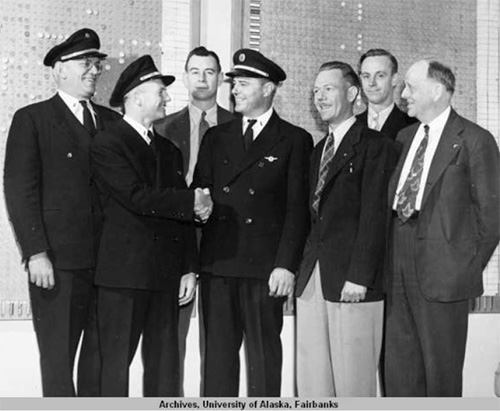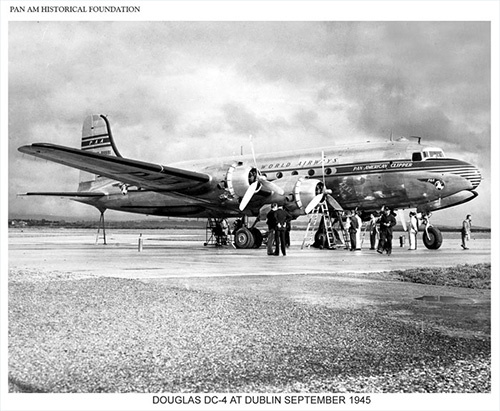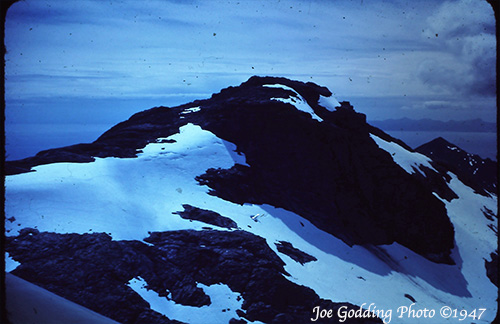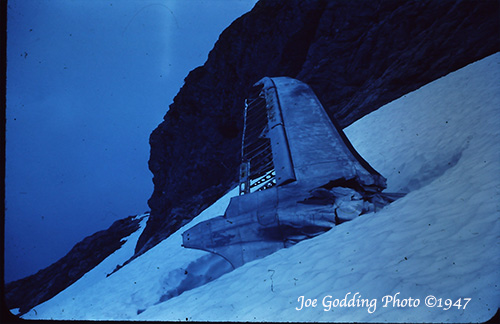
Deadly plane crash led to creation of Ketchikan Volunteer Rescue Squad1947 Pan Am crash on Tamgas Mountain killed 18By DAVE KIFFER
October 24, 2017
Up until recently, people climbing the mountain could still find pieces of the wreckage and metal from the flight, but the crash had another legacy to the Southern Southeast region. It led to the creation of the Ketchikan Volunteer Rescue Squad, an organization that has saved hundreds of people in the decades since. Like many early aviation accidents in Alaska, authorities were never able to pinpoint a specific cause to the crash of Pan Am flight #923 from Seattle to Alaska. But it was clear that weather played a significant role as the last communications with the plane indicated that pilot Alf Monsen, one of the most experienced pilots in the state, was fighting to control the plane in severe turbulence.
Ironically, Monsen was Pan Am's "weather guru" and had actually written manuals explaining how to deal with the challenges of flying in Alaska weather. He was also on his final flight before retiring to join his wife Helen in Juneau. Helen Troy Monsen was the daughter of the former territorial governor John Troy. She was also the owner/publisher of the Alaska Daily Empire in Juneau. Alf Monsen – who had been one of Alaska’s pioneer bush pilots in the late 1920s – planned to take over the Alaska Coastal Airlines company when he retired from Pan Am. Not long before the crash, Monsen had written his wife several letters indicating he was unhappy with Pan Am, particularly in how the company often sent flights and pilots into unsafe situations with a lack of up to date weather info. Monsen's letters and other Troy family material fill up several boxes in the Alaska State Archives in Juneau. Flight 923 from Seattle to Juneau was a route that Monsen had flown dozens of times. He and his first officer Laurance Foster were very experienced with the run and the plane, a Douglas DC-4, nicknamed the Clipper Talisman. Monson was approaching 13,600 hours of flight time, with more than 500 in DC-4s. Foster – who was normally a captain but had been downgraded to first officer because of Pan Am budget cuts - had 12,400 flight hours with 359 in DC-4s. Both pilots had been trained on DC-4s seven months before when the DC 4s had been put into service by the airline. The plane, with five crewmembers and 12 passengers (plus an infant), lifted off from Boeing Field at 10:30 am. It soon reached its cruising altitude. "About an hour into the flight, the view was lost when thick clouds engulfed the aircraft, obscuring all outside references," Aviation historian Gregory Liefer wrote in his 2014 book "Broken Wings: Aviation Disasters in Alaska." "Light icing and turbulence were encountered soon after, bouncing the plane with jolts strong enough to prevent the passengers from sleeping. Those passengers inexperienced with flying remained on edge, but the crew considered the conditions fairly routine." The last weather report the crew received before leaving Seattle indicated normal weather for late October in Southeast Alaska. A copy of that report is in the Juan Trippe Pan American Archives at the University of Miami. Flight 923 was to expect "moderate turbulence" and some wind gusts to 30 mph when it arrived in Southeast Alaska. In the event, the plane was unable to land at its intermediate stop at Annette Island near Ketchikan, it had more than enough fuel on board to reach Juneau or return to Seattle if necessary. The DC-4 was carrying enough fuel for 12 hours of flight and the trip to Juneau would take less than half that amount of time. When the flight was three hours of out Seattle, it began its approach to Annette. It received an updated report from the Annette airport. There was a ceiling of 1,400 feet and visibility of three miles. It was raining and the wind gusting between 16 and 35 knots. Once again, the crew would likely have not been concerned because the DC-4 was fully capable of landing in such conditions. Air traffic control cleared the plane to descend to 7,000 feet and continue its approach. Because 3,600 foot Mt. Tamgas was south of the airport, the Clipper Talisman had to go past the Annette airport, double back, and land from the northwest.
At 1:38 pm, Monsen acknowledged the approach clearance. But almost immediately something began to go wrong. At 1:43 pm, the crew radioed that the flight was experiencing "extreme turbulence" according to the Civil Aeronautics Authority report on the crash. "Proceeding Juneau due extreme turbulence," First Officer Laurence Foster radioed, according to Pan Am’s internal report on the crash, which is part of the University of Miami archives. This was not an unusual occurrence, especially since the flight had more than enough fuel to reach Juneau. The controller immediately radioed back to get the plane's location and altitude, but the call went unanswered. Several other attempts were made to contact the plane but there was no response. At 2:01 pm, a distress alert was sent out. On the ground at Annette, the weather had worsened as a front was moving across the area, preventing any search flights from leaving the airport. Another commercial flight arrived three hours later and reported moderate icing during the descent and severe turbulence near the ground. The CAA report said the turbulence during the second plane's landing was severe enough to make the cockpit gauges nearly unreadable. A military transport at Annette took off around 7 pm that evening and also reported severe turbulence shortly after takeoff. The transport also encounter icing above 4,500 feet that was so severe the plane returned to the field. Meanwhile, the storm was intensifying with gusts to 55 knots and visibility nearly zero at points. Three military search and rescue planes had been dispatched from Fairbanks and were able to search the route between Juneau and Annette but could not search around Annette Island itself. Three Coast Guard cutters from Ketchikan and Sitka were also dispatched. The next day, weather had improved enough to allow more search operations, although the clouds were still obscuring most of the higher mountain peaks in the area. By the end of the second day, 19 different planes were searching for the lost flight. "The bulk of the search initially focused around the Juneau area," Liefer wrote. "Misleading reports had placed the missing flight in the area ... several residents reported hearing a circling aircraft near the northwest tip of Admiralty Island."
Other reports indicated a plane heard near Funter Bay. Another report was made of a loud explosion near Douglas Island. It took a couple of days, but those reports were found to be not related to the missing plane. Meanwhile, another storm had arrived at Annette Island, limiting the search there. By the third day, nearly 40 planes and dozens of boats were involved in the search. But despite the hundreds of hours of search time, no sign of Pan Am 923 was found. The next day, the clouds cleared and searchers headed for Tamgas Mountain. At 6:45 am, a Pan Am plane, piloted by Monsen's son Wesley, spotted the wreckage 200 feet below the summit of the mountain, six miles east of the airfield. It was immediately known that no one could have survived the impact and the fire than then engulfed the plane. Wreckage was strewn over a significant area of the mountain and only the tip of one wing and the tail of the plane remained relatively intact. Ground parties were sent to inspect the wreckage and reached the site by that evening. There was already several fresh inches of snow on the crash site. Initially, workers removed the remains of the crew and passengers and brought them down the mountain, a process that took more than two days in the extremely steep terrain. More snow fell as they worked and the CAA investigators decided to delay the crash investigation until the next spring when the snow melted. When she heard the investigation would be delayed several months, Helen Monsen sent several letters to her friends in the federal government, asking their help in pressing the investigation. But the CAA denied her requests, according to the letters in the state archives. Officials from Pan Am also concurred that the terrain was too steep to safely finish the investigation and that the increasing snow pack would preserve the remains of the plane until the next summer. Almost immediately, there was speculation about the causes of the crash. On November 1, 1947 there was an article produced by the Associated Press that appeared in newspapers across the country. “Aviation charts showing Tamgas Mountain to be 3,610 feet high were blamed for the crash of the Pan-American DC-4,” the wire service reported. “Newspapermen flying in the area said that when their plane approached the level of the DC-4’s wreckage, the altimeter showed 3,400 feet – and the peak loomed several hundred feet higher. The mountain apparently is 4,000 or 4,100 feet high. Pilots said several peaks in Southeastern Alaska are improperly marked on charts.” But while it was likely true that some charts were off, Tamgas was – and is – 3,591 feet high by modern calculations. The CAA would not return to the crash site until late in August of 1948, when the snow cover left the top of Tamgas Mountain. The impact point was determined to be about 50 above the majority of the wreckage, just about 150 beneath the peak. It was determined that the plane was climbing at about 20 degrees, but because of the damage to the propellers it was not possible to determine the climbing speed. A flash fire occurred shortly after impact, but there was no evidence of a fire or mechanical problems before impact, according to the CAA accident report. With the exception of an on-board compass, all the other flight instruments were destroyed by the crash and fire and unreadable.
The CAA report also noted that an internal Pan Am weather forecast for the Annette area misinterpreted the potential severity of the winds that Flight 923 could expect, although the CAA also said it was impossible to determine whether this particular forecast ever reached the flight crew because the plane was already preparing to take off. “The original forecast was in error in respect to wind velocities,” the CAA report concluded. “It should have been evident to the company meteorologist that the synoptic situation existing over the northeast Pacific would result in crowded isobars along the Canadian and southeast Alaska coast. Had this been realized, he would have forecasted much more severe turbulence at low altitudes in ample time for the information to have been available to the pilot either before or shortly after his departure from Seattle.” Another factor that got the CAA attention was a deviation in the Annette Island Radio Range of about 3 ½ degrees. Liefer, in his book, makes that case that deviation in the range finder could have caused the plane to fly into Tamgas Mountain, but the CAA drew the opposite conclusion. In sum, the CAA said it was not possible to conclusively find the cause of the crash. “Severe turbulence may have caused the loss of control of the airplane,” the report concluded. “There may have been severe icing which resulted in the loss of control … there is no real evidence to support any particular theory for the cause of this accident. Pan Am’s own internal report on the accident, in the Pan Am archives in Miami, concludes that “weather probably was the major contributing factor to this accident … extreme turbulence resulted in the lack of ability to maintain absolute directional and attitude control of the aircraft … over five years’ flight experience through the Annette area is sufficient evidence that the pilot and/or copilot would not intentionally turn toward the eastern terrain areas (of Tamgas Mountain, which was approximately 6 miles east of the runway). Alf Monsen was born in Norway in 1900 and had first come to America in 1906 with his family from Norway. More than 200,000 Norwegians emigrated to America between 1880 and 1910. Many joined American farming communities in the Great Plains, while a large number of families moved to the Pacific Northwest for the boundless fishing industry which was in stark contrast to the overfished industry back home. But like many immigrants, the Monsen’s returned home within two years. By 1910, they were back in America and Alf Monsen was attending public school in Oakland, California, where his parents would continue to live into the 1940s. In 1917, Alf Monsen moved to Alaska work on the Alaska Railroad. He returned to California, but by 1920 was back in Alaska working with the railroad again. In 1921, he married Margaret Simonsen, they had two boys, Wesley and Albert. Monsen continued to work for the railroad off and on througout 1920s, but at some point the flying bug hit and in 1928, he became a pilot. At least one source indicates that he received his flight training in Oakland. Although not among the “famous” bush pilots of his era, Monsen shows up in numerous accounts of other pioneer aviators like Frank Barr, Noel Wien and Merle “Mudhole” Smith. He also gets brief mentions in books by Archie Satterfield and Jean Potter’s classic “The Flying North.” For example, in Steven Mills and James Phillips's 1969 book "Sourdough Sky," Monsen is briefly mentioned five different times in different situations usually involving search and rescues of one sort or another. It seemed that he was always either providing a flight in or flight out of challenging situations. In one sticky situation, in February of 1932, he flew out to Summit Lake in the Alaska Range to rescue a railway worker who had developed gangrene in his frozen hands at 60 below zero. "He virtually landed blind in a snowstorm to pick up his passenger," Mills and Phillips wrote. "Out and back, the only route through mountains was along the railroad track which ran through mountain canyons, wound along narrow gorges and, at times, through tunnels. How Monson with visibility almost nil managed to follow the track for more than 100 miles in a blinding snowstorm is one of the old-timer's favorite miracles of Alaskan aviation." They go on to report that "Railroad men swore that Monsen flew so low he knocked over stove pipes on the section houses along the rail line." Monsen would later joke that he just folded back the wings of the Fairchild he was flying in order to go through the tunnels, Mills and Phillips wrote, noting that the Fairchild was one of the few planes that had collapsible wings for easier storage. He developed a reputation as a reliable flyer and was often called in to take over operations for bush pilots who were out of commission because of crashes. He pioneered many routes along the Anchorage-Bethel cooridor and also in the Cordova and Valdez areas. He flew some of the first air mail routes along the Yukon and to McGrath and other isolated inland communities. Among the other pilots; Monsen was called “Big Money Monsen” because his favorite saying was “time is money.” No matter what the conditions, Monsen seemed able to get through. And usually on time. In February 1931, Monsen went to work for Pacific International Airways in Anchorage. In 1932, Pan Am bought out Pacific International. Monsen would fly for Pan Am for the next 15 years, eventually becoming its senior Alaskan pilot and one of the most experienced captains in the fleet. He wrote several manuals on flying in heavy weather and was frequently called upon to train Pan Am pilots throughout their fleet. “Alf Monsen was a very dignified guy and a steady type,” said the late Lew Williams Jr. in an interview in 2008. Williams worked at the Daily Empire when Helen Troy Monsen was the publisher. “He was no risk taker. The time I flew up with him and his son in an old Lockheed Electra, we spent the night at Prince George rather than push through the mountains to Ketchikan and then to Juneau. The weather wasn’t that hot. Alf didn’t push his luck. I remember being surprised that he crashed, he had flown that route so long.” By the late 1930s, Monsen had divorced Margaret Simonsen. On Oct. 11, 1941 he married Helen Troy Bender, the daughter of former Alaska territorial Governor John Troy. Bender’s previous husband had died in 1937. She was the editor and publisher of the Juneau Empire. By the early 1940s, Monsen’s son Wesley had also become a pilot and was flying the Alaska route for Pan Am. There is a picture of the two men together in a Pan Am cockpit in the 1943 Pan Am annual report, noting they were the airline’s first father-son combination. Also in 1943, Alf Monsen finally became a US citizen. In the Alaska state archives, there is a letter from Monsen to the Immigration and Naturalization Service, applying for citizenship because Pan Am was seeking to have all its pilots inducted into the US Naval Reserve as part of the war effort. In the Alaska state archives in Juneau there are several surviving letters between Alf Monsen and Helen Monsen. Most are from their courtship period in the late 1930s up until their marriage in 1941. But there are also several letters from 1943 to 1947 and it is obvious that Alf Monsen is looking forward to retiring from Pan Am. He talks at length about how the stress level in his job has increased as well as his work load. “I have (had) a trying week and am worried so much about my stamina,” he wrote in April, 1947. “I am not in very good shape, so this has sure taken me down.” Two months later, he notes that the stress of flying increased schedules for Pan Am is also beginning to get to him. He mentions several challenging recent flights (he was based in Seattle at that time and was only getting home to Juneau sporadically. “It is my job to take the worst trips,” he concludes. Also in the archives is a copy of a letter, apparently unsent, from Helen Monsen to a Pan American official complaining about her husband’s treatment by a superior. Monsen had apparently been raising concerns about flight conditions and how Pan Am’s rapid increase in operations in the post war years was potentially compromising safety. Helen Monsen wrote that the superior had told Al “on the basis of this, I can fire you at any time, if I want to.” “Then the persecution of Al began,.” Helen Monsen wrote. She noted that it was apparent that Al’s flying “record” at Pan Am was being distorted in order to discredit him. Pan Am was also in the process of promoting several other pilots, who were junior to Alf Monsen, over him in the pecking order. “Is there any way in which Al’s record can be investigated and cleared,” Helen Monsen concludes in the unsent letter. Two months later, Alf Monsen, would die, on his last flight before retirement, on Tamgas Mountain. Alf Monsen was buried in Evergreen Cemetery in Juneau next to his father in law, the former territorial governor. Helen Troy Bender Monsen died at age 91 at a nursing home in Indio, California on July 4, 1989. She was cremated and buried in Evergreen Cemetery in Juneau next to her father and second husband. After selling the Empire in 1955, she worked in the state attorney general’s office in Juneau until 1966 when she retired and moved to Palm Desert, California. Wesley Monsen continued to fly for Pan American Airways, eventually becoming a 747 pilot. He retired from Pan Am in 1982, after 38 years and spent his retirement in Rocklin, California. He died on May 2, 2011 at the age of 89. When the Pan Am flight 923 was reported missing it set off one of the largest searches in Ketchikan history. Dozens of planes and boats and hundreds of volunteers were involved until the wreckage was discovered. Among the early searchers was Ketchikan resident Dick Borch, a fish buyer and experienced outdoorsman who immediately organized a volunteer search effort. Borch and other local residents such as Ralph Homan were among the first people on the scene on Tamgas Mountain. Coming only four years after the tragic crash and subsequent rescue of the passengers on Harold Gilliam’s ill-fated flight (See “Harold Gillam, A Tragic Final Flight, SITNEWS Aug. 17, 2004) in which several weeks elapsed before survivors were found, the Pan Am crash convinced Borch and local helicopter pilot Ken Eichner to establish a volunteer rescue squad. Ketchikan Volunteer Rescue Squad members continue to volunteer hundreds of hours each year looking for lost hikers, fishermen, and visitors throughout Southern Southeast Alaska. They are considered the model for other regional search and rescue groups throughout Alaska.
On the Web:
Contact Dave at dave@sitnews.us Dave Kiffer ©2017 Representations of fact and opinions in comments posted are solely those of the individual posters and do not represent the opinions of Sitnews.
|
||||||



